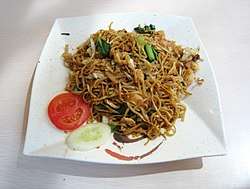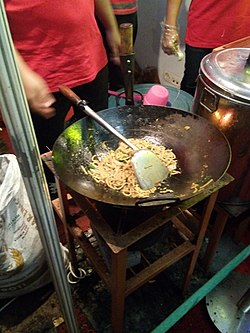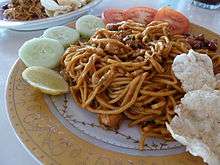Mie goreng
Mie goreng (Indonesian: mie goreng or mi goreng; Malay: mee goreng or mi goreng; both meaning "fried noodles"[2]), also known as bakmi goreng,[3] is an often spicy fried noodle dish, originating from Indonesia, common in Malaysia, Brunei Darussalam, and Singapore.[1][4] It is made with thin yellow noodles stir fried in cooking oil with garlic, onion or shallots, fried prawn, chicken, beef, or sliced bakso (meatballs), chili, Chinese cabbage, cabbages, tomatoes, egg, and other vegetables. Ubiquitous in Indonesia, it is sold by food vendors from street-hawkers, warungs, to high-end restaurants. It is an Indonesian one-dish meal favourite, although street food hawkers commonly sell it together with nasi goreng (fried rice).[5] It is commonly available at Mamak stalls in Singapore, Brunei, and Malaysia and is often spicy. In Sri Lanka, mee goreng is a popular dish due to Malay cultural influences and is sold at street food stalls around the country.[6]
 Mie goreng in a restaurant in Jakarta | |
| Alternative names | Mee goreng or Mi goreng |
|---|---|
| Type | Noodle |
| Course | Main course |
| Place of origin | Indonesia[1] |
| Region or state | Maritime Southeast Asia |
| Serving temperature | Hot |
| Main ingredients | Fried noodles with chicken, meat or prawn |
Origin

Chinese influences are evident in Indonesian food, such as bakmi, mie ayam, pangsit, bakso, lumpia, kwetiau goreng, and mie goreng.[7] The dish is derived from Chinese chow mein and believed to have been introduced by Chinese immigrants in Indonesia.[4] Despite being influenced by Chinese cuisine, mie goreng in Indonesia have a definite Indonesian taste, it has been more heavily integrated into Indonesian cuisine;[8] for example the application of popular sweet soy sauce that add mild sweetness,[9] sprinkle of fried shallots, addition of spicy sambal and the absence of pork and lard in favour of shrimp, chicken, or beef; to cater for the Muslim majority.
Asian stir fried noodle akin to mie goreng is arguably can trace its origin to China. In Malaysia and Singapore; however, the dish is believed to have been created by Indian immigrants who drew influences from their own as well as other cultures.[10][11] Mee Goreng, which is fried yellow noodles commonly found in Malaysia, is commonly sold in Mamak stall; Mamak is a local term for Muslim Malaysian Indians hawkers. The Mamaks borrowed noodles from their Chinese counterparts and create their own spicy version. The naming in Malay: mee goreng is also meant to signify that it is a halal food; cooked by Indian-Muslim in Malaysia, in contrast to Malaysian Chinese version that often non-halal and retain its original Chinese names. The Malaysian Indian mee goreng mamak is a Malaysian phenomenon, since this version cannot be found in India itself.[12]
Variations
Mie goreng are traditionally made with yellow wheat noodles, stir fried with chopped shallots, onion, and garlic with soy sauce seasoning, egg, vegetables, chicken, meat or seafood. However, other versions might use dried instant noodle instead of fresh yellow wheat noodle. The powdered instant noodle seasonings are usually included in the dish, added with egg and vegetables, they are common in Indonesia and Malaysia. Authentic mie goreng uses fresh ingredients and spices, however, bottled instant spice paste might be used for practical reasons.[13]
The almost identical recipe is often used to create other dishes. For example bihun goreng is made by replacing yellow wheat noodle with bihun or rice vermicelli, while kwetiau goreng uses shahe fen or thick flat rice noodles instead.
Indonesia
A number of mie goreng variants exist. In Indonesia mie goreng variants are usually named after the ingredients, while some might be named after the region of origin.
- Mie goreng ayam or common mie goreng uses chicken with shallots, garlic, leek, sweet soy sauce, egg, and vegetables typically added as well.
- Mie goreng ayam penyet mie goreng topped with ayam penyet smashed fried chicken with sambal.
- Mie goreng sapi, similar to common traditional mie goreng, but uses beef instead.
- Mie goreng kambing uses goat meat or mutton.
- Mie goreng udang uses shrimp.[4]
- Mie goreng seafood uses seafood which includes mixture of fish, squid, and shrimp.
- Mie Goreng Aceh a mie goreng variant from Aceh province, which uses a thicker noodle similar to that of spaghetti, and employs a curry-like rich spicy paste.[14]
- Mie goreng Jawa from Central Java, employ sweet soy sauce, egg, chicken, and vegetables. In restaurant, warung or travelling food vendor, it usually sold and offered together with mie rebus (lit. "boiled noodle") or mie Jawa.[15]
- Mie goreng tek-tek refer to mie goreng sold by travelling street hawkers that hitting the wok making "tek-tek" sounds to announce their wares. The seller with his food cart frequenting the residence areas, usually also offers nasi goreng and mie rebus. It is common in Jakarta and some large cities in Java.
- Mie goreng dhog-dhog also known as Mie goreng Surabaya from Surabaya city. Refer to travelling food cart vendor selling mie goreng Surabaya that uses large wooden slit drum instead to announce his presence in the neighbourhood, thus creates "dhog-dhog" sounds.[16]
- Indomie Mi goreng the instant version of mie goreng, Indomie Mi goreng is also popular in Indonesia and other countries, notably Netherlands, Nigeria, Australia, New Zealand, United States and several Middle Eastern countries.[17] This instant version however, is not technically goreng (stir-fried), but boiled instead and seasoned after discarding the water used for boiling. Nevertheless, it tries to closely resemble the authentic mie goreng by adding sweet soy sauce and crispy fried shallot. It is commonly found in warung Indomie stalls that sell instant noodles, grilled sandwiches and hot drinks in Indonesian urban areas.
Indonesians tend to name similar foreign dishes as mie goreng, for example in Indonesia, chow mein is often called mie goreng Tionghoa and yakisoba is called mie goreng Jepang.
Malaysia
In Malaysia, mie goreng is associated with Malaysian Indian cuisine and is famous for being prepared and sold at Mamak stalls around the country. The dish has spawned unique variations found in Malaysia and neighbouring Singapore.[18][19]
- Mee goreng mamak. A common variation of mie goreng is mee goreng mamak which is sold at Mamak stalls run by Indian Muslims in Malaysia. This variation is distinguished from others through the use of spices, tomato sauce, potatoes, sweet soy sauce, and curry spice. Chilli is another common ingredient used in this dish.[20][21][22]
- Maggi goreng is a variation originating from the Indian Muslim community and sold in Mamak stalls around Malaysia. It uses Maggi instant noodles instead of standard yellow noodles.[23]
Singapore
In Singapore, the availability of mie goreng is largely similar to that found in Malaysia, including the Mamak version. Singapore is also home of the Punggol mie goreng, so called due to its origins at the Punggol End bus station. It is closely related to the Peranakan Chinese-style mie goreng, and includes stir-fried rempah, yellow Chinese noodles, seafood (typically prawns). Some versions include the addition of imitation crab, cabbage, and bean sprouts.
Gallery
- Basic mie goreng tek-tek sold by travelling street vendor
- Mie goreng with chicken and shrimp in Jakarta
- Mie goreng served as part of hotel breakfast buffet
 Mie goreng Aceh
Mie goreng Aceh- Mie goreng and nasi goreng combo, a hotel breakfast buffet
See also
References
- Bergy (18 September 2006). "Indonesian Mie Goreng (Fried Noodles)". Food.com.
- Guerin, Bill (23 December 2003). "World's top noodle maker loses its bite". Asia Times Online. Retrieved 22 August 2007.
- Sara Schonhardt (25 February 2016). "40 Indonesian foods we can't live without". CNN.
- Ben Hinson. "Mie Goreng (Indonesian Fried Noodles)". Recipes from around the world.
- Pepy Nasution (7 March 2012). "Friend's Post – Mie Goreng by Indonesia Eats". Wok With Ray. Archived from the original on 13 June 2012. Retrieved 3 June 2012.
- "Mee Goreng". Unilever. Archived from the original on 15 December 2017. Retrieved 1 February 2018.
- Heinz Von Holzen (2014). A New Approach to Indonesian Cooking. Marshall Cavendish International Asia Pte Ltd. p. 15. ISBN 9789814634953.
- "Indonesian Food: 50 of the Best Dishes You Should Eat". Migrationology. 2016-05-22. Retrieved 2020-02-16.
- Janelle Bloom (August 2001). "Mie goreng". Taste.com.au Australian Good Taste.
- Chen, Kuan-Hsing (1998). Food of Malaysia: 62 Easy-to-follow and Delicious Recipes from the Crossroads of Asia. Psychology Press. p. 70. ISBN 0415153247.
- Hutton, Wendy (2005). Trajectories: Inter-Asia Cultural Studies. Tuttle Publishing. p. 166. ISBN 1462916376.
- "Indian Mee Goreng (Indian Fried Noodles)". rasamalaysia.com. Retrieved 2020-02-16.
- "Indonesian Fried Noodles (Mie Goreng)". Rasa Malaysia. 9 August 2010.
- "Mie Aceh Recipe". Indonesian Recipes.
- "Mie Goreng Jawa". Tasty Indonesian Food.
- Rinny Ermiyanti Yasin (1 February 2012). "Diferensiasi: Antara Tek-tek dengan Dhog-dhog" (in Indonesian). Kompasiana. Archived from the original on 11 July 2012. Retrieved 3 June 2012.
- "Indomie Goreng". Indomie (in Indonesian). Archived from the original on 2017-04-29. Retrieved 2017-03-24.
- Singapore, National Library Board. "Mee goreng - Infopedia". eresources.nlb.gov.sg.
- "Adam Liaw's Mee Goreng - InDaily". indaily.com.au. 23 September 2014.
- "Mamak Mee Goreng". kampungsingapura.com. 1 May 2013.
- Dupleix, Jill. "Indian mee goreng". Good Food.
- "Indian Mee Goreng (Indian Fried Noodles) - Easy Delicious Recipes". rasamalaysia.com.
- "3-Step MAGGI® Goreng Mamak".
| Wikimedia Commons has media related to Mie goreng. |